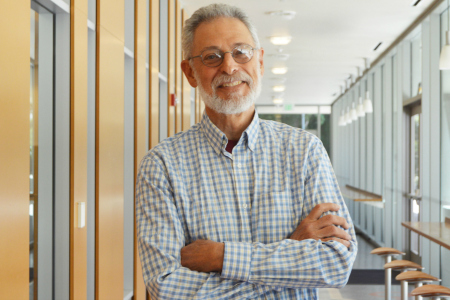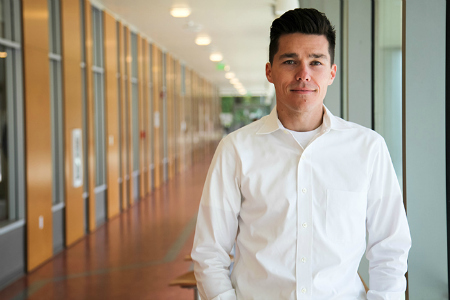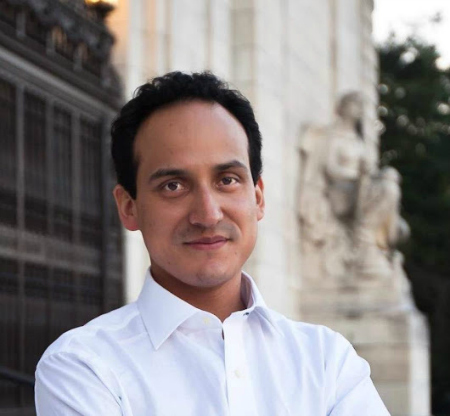The headlines are all too familiar: Wall Street can’t be trusted, the little guy loses, and the stock market is rigged. For a team of economists at UC Santa Cruz it’s time to stop the problems burdening financial markets.
Instead of punishing bankers and investors for exploiting the market, Daniel Friedman, Eric Aldrich and Kristian Lopez Vargas believe it’s about making fundamental changes to a system that lets them get away with it.
“How can financial markets become part of the solution instead of a big part of the problem with the modern world?” asks Friedman, a distinguished professor of economics who is exploring ways to make financial markets work better and fairer.
Making Wall Street fair might seem impossible, but to Friedman and his collaborators at UCSC Eric Aldrich and Kristian Lopez, it’s more of a game. The three economists have devised a computer game that simulates alternative trading formats - including IEX, the market that rose to fame after being featured in Michael Lewis’ best-selling book Flash Boys.
The economists’ computer game was developed in Friedman’s Learning and Experimental Projects (LEEPS) lab, a hub on campus that has tested how human behavior and psychology impact economic decision-making in financial markets for over 30 years.
Friedman has dedicated his career to understanding how incentives influence behavior and market outcomes. In 2008, he co-authored Morals and Markets (Palgrave Macmillan, 2008), an influential book that explores how market systems can elicit questionable conduct by rewarding the very actions that threaten economic stability.
Now Friedman is putting some of his theories to the test and is looking at the largest financial exchange in the world: the New York Stock Exchange (NYSE).
When trading went electronic in 1990s, the NYSE adopted an electronic trading format called the Continuous Double Auction (CDA). In the CDA, traders make publicly committed offers to buy and sell stocks at any point in time. If there are two offers at the same price, the exchange gives the trade to whoever got there first.
In an electronic CDA format, speed is crucial.
“After the electronic CDA was introduced, traders began competing over time and not over price,” says Friedman.
The competition over speed has resulted in trading firms investing billions of dollars into building infrastructure that helps them be first in the trading queue.
“Timing became more important than it should be, while pricing became less important than it ought to be,” he says.
The problem with the current market format? It’s a high speed arms race.
Currently, there are 12 official exchanges in the US. They operate as an integrated system, communicating with each other whenever a trade is made. Any transaction will affect a stock’s price across the network. Exchanges are always having to update market information to reflect when a stock’s value goes up or down.
Inevitably, there is a time lag in communication.
Exploiting this time lag is a type of trading called high-frequency trading (HFT).
HFT firms operate at the microsecond level. The human brain can’t even comprehend time that granular. It takes about one million microseconds (one second) to even read the word microsecond, 500,000 microseconds for a finger to click a computer mouse, and 350,000 microseconds to blink an eye.
Powered by sophisticated computers, advanced algorithms, and state-of-the art communication infrastructure, HFT firms act at such a rapid-fire rate that some exchanges don’t have the bandwidth to react to the new information they send out.
“High-frequency traders use speed to ‘game the system’ by moving so fast that exchanges cannot react in time to protect slower traders when new information is out in the market,” says Lopez Vargas about how the way exchanges currently operate.
By the time exchanges are updated to reflect changes in a stock’s value, HFT algorithms will have already swept in and picked off–or what traders called “sniped”–any open “stale” orders available at the old price. It doesn’t end there. HFT firms will rapidly sell back the stock at the new rate, sometimes even trading it back to the seller if they have an open offer on other exchanges that has not been cancelled yet (it is common for investors to have open offers as they search for the best rate).
HFT is big business with big profit. Over half of trades in the US are now executed through this method. Through finding a flaw in the market design, these firms have skimmed billions of dollars off the stock market. Some say that HFT firms are only being opportunistic. They found a flaw in the market design and exploited it to their advantage.
Paying the price are ordinary investors – the people charged with investing a public school teacher’s retirement fund or a first-time homeowner’s insurance policy – who can’t keep up with the cost of staying ahead of the strategies HFT firms deploy. Instead, they end up being sniped.
Some argue that high-frequency traders provide some benefit to the market: in the current system, they take the role of market makers who are willing to both buy and sell assets at very competitive prices, says Aldrich.
“Economists have investigated the role of HFT from many perspectives, and while there is no question that ordinary investors are exploited at specific times, they are also benefited with immediate liquidity and competitive prices at other times,” adds Aldrich about the academic literature that shows the net effect of HFT to be positive.
This doesn’t mean that the market system is optimally designed.
Rather, Friedman, Aldrich and Lopez Vargas are interested in finding ways to eliminate aggressive, costly behavior while maintaining the good.
“Throughout history, markets have been exploited by a subset of savvy traders. In the age of electronic markets, these happen to be HFT,” says Aldrich. “We don’t demonize HFT any more than my Golden Retriever who ate a pie that was left uncovered on the kitchen counter - they are simply responding to compelling incentives. Rather than putting a Band-Aid on HFT, we’re looking for ways to realign incentives through market design.”
Cracking the code to market rigging
“The key is not simply finding and punishing ill behavior, the key is to devise a set of market rules that induce the right behavior all by itself,” says Lopez Vargas.
One way to prevent exploitative actions (like sniping and rebate arbitrage*) used by high-frequency traders is to simply slow information down, which is what the Investors Exchange (IEX) is doing. Set up in 2013, IEX eliminates the unfair advantage of speed by slowing down trades. All trades operate at a 350 microsecond delay, long enough for stock prices to readjust after a trade but fast enough to still be a competitive market exchange.
"IEX was one of the first exchange to confront the problems caused by HFT and try to level the playing field," says Friedman, who just completed an in-depth analysis with Aldrich about the exchange. IEX recently rose to fame after being prominently featured in Michael Lewis’ best-selling book, Flash Boys.
In the economists’ computer game developed in the LEEPs lab, the researchers are testing the idea of a time delay that underpins IEX’s model.
To test how speed influences trading behavior, the researchers present players with the same strategies high-frequency traders use. They ask players to choose whether they want to play the role of a sniper or market maker (market makers are traders who buy and sell stock, whereas snipers’ only purpose is to target time lags).
So far, initial findings from their studies are positive.
The economists discovered that when access to speed technology is eliminated, players have more incentive to trade competitively. In their early theoretical findings, Aldrich and Friedman found that the IEX model eliminates sniping behavior without impacting the number of market makers, the traders that ensure financial markets are liquid and effective. They find that stock price efficiency is improved.
But as the researchers point out, IEX on it’s own is not enough to promote market fairness.
“IEX by itself cannot protect against sniping,” says Friedman.
It only protects pegged orders, a specific order to buy or sell at the price set by the National Best Bid Offer (NBBO), the centralized regulator that lists the current price of every single stock. “It must rely on the other exchanges (such as NASDAQ) to detect changes in the price,” he adds.
Information on the IEX is contingent on a market format contaminated by HFT trading practices and sniping.
The Frequent Batch Auction
Another solution is a new format that deviates from the CDA entirely: the frequent batch auction (FBA). Instead of trading continuously, trading happens in short intervals. Orders can be grouped in batches, with offers going to the best bidder and not the fastest one.
Proposed by Eric Budish of the University of Chicago, University of Maryland's Peter Cramton, and John Shim from the University of Chicago, the idea is that instead of trades happening continuously, the trading day is broken up into many auction periods.
Restoring faith in financial markets means more than changing a system, it involves changing the concept of time itself. Time no longer flows continuously but is fragmented, marked by short intervals. It is discrete instead of continuous.
Until now, the FBA format has only existed in theory. FBA is another market formats that Aldrich, Friedman, and Lopez Vargas are testing.
The early results of their testing are confirming what Friedman, Aldrich, and Lopez-Vargas suspected: altering the market rules in a clever way can discourage unnecessary competition over speed and instead refocus competition over price.
“The U.S. Securities and Exchange Commission has long regulated stock prices to trade in discrete values [currently, trades are in penny increments] but has never regulated time increments,” Aldrich notes.
“Our initial results with batch auctions are interesting because they suggest that regulating time increments may be beneficial to markets,” Aldrich adds
Friedman, Aldrich, and Lopez Vargas’s research is ongoing. They hope to schedule a gaming tournament in 2018 with industry professionals so they can assess how different models with impact real trader behavior. Crampton and Axel Ockenfels at the University of Cologne are key research partners.
From gaming the system to changing it
Friedman is worried that HFT may undermine the social purpose of financial markets.
“Asset prices are supposed to distill widely dispersed information and to channel society's resources into the most promising directions. HFT could be throwing sand in the gears and keeping financial markets from doing what they are supposed to do,” Friedman says.
When a market is designed where profit can be made by speed alone, a company’s fundamental value becomes impossible to truly determine. Their stock price is only superficial, making it impossible to determine what they are really worth.
What Friedman, Aldrich, and Lopez Vargas show is that even with sophisticated computers and algorithms, financial markets are still a social system driven by human behavior. Social action and market calculation are constantly at play, with agents making rational (and yes, sometimes risky) choices.
“The financial system is a vital part of civilization,” says Lopez Vargas. “Put simply, it is our way to make complex, highly-worthy enterprises possible. Finding clever ways to keep the system functional in that important role is, at the end of the day, the ultimate goal of this research.”
This project was made possible thanks to support from a seed grant from the UCSC Center for Analytical Finance (CAFIN). CAFIN will be co-hosting a conference on the topic of market design and regulation in a high-frequency trading world with the Global Research Unit at the Department of Economics and Finance, City University of Hong Kong at the City University of Hong Kong, Dec. 7 & 8, 2017.
Future work will be supported from a subaward from an ERC grant to Axel Ockenfels at the University of Cologne. Interested in supporting research at LEEPs? Make an online donation here.
The LEEPs lab has the second longest-running fully computerized market system in the world. LEEPS was founded in 1986 with a National Science Foundation grant to study how the sequence of market information impacted stock prices in Continuous Double Auction markets, the format still used by the New York Stock Exchange (NYSE) and NASDAQ to trade stocks. In the 1990s, LEEPs also developed and tested an early version of the FBA format called MCM Multiple Call Markets, documented in detail in Friedman's book The Double Auction Market: Institutions, Theories and Evidence (Addison-Wesley, 1993).



